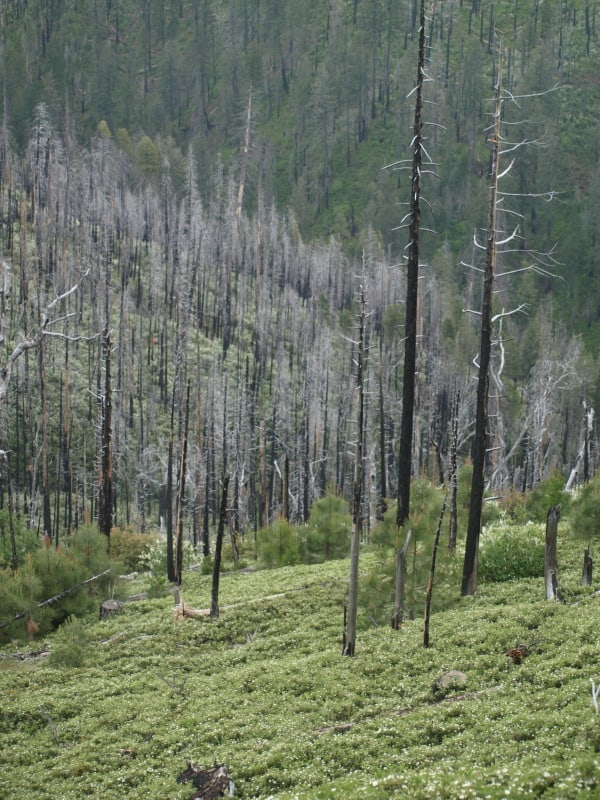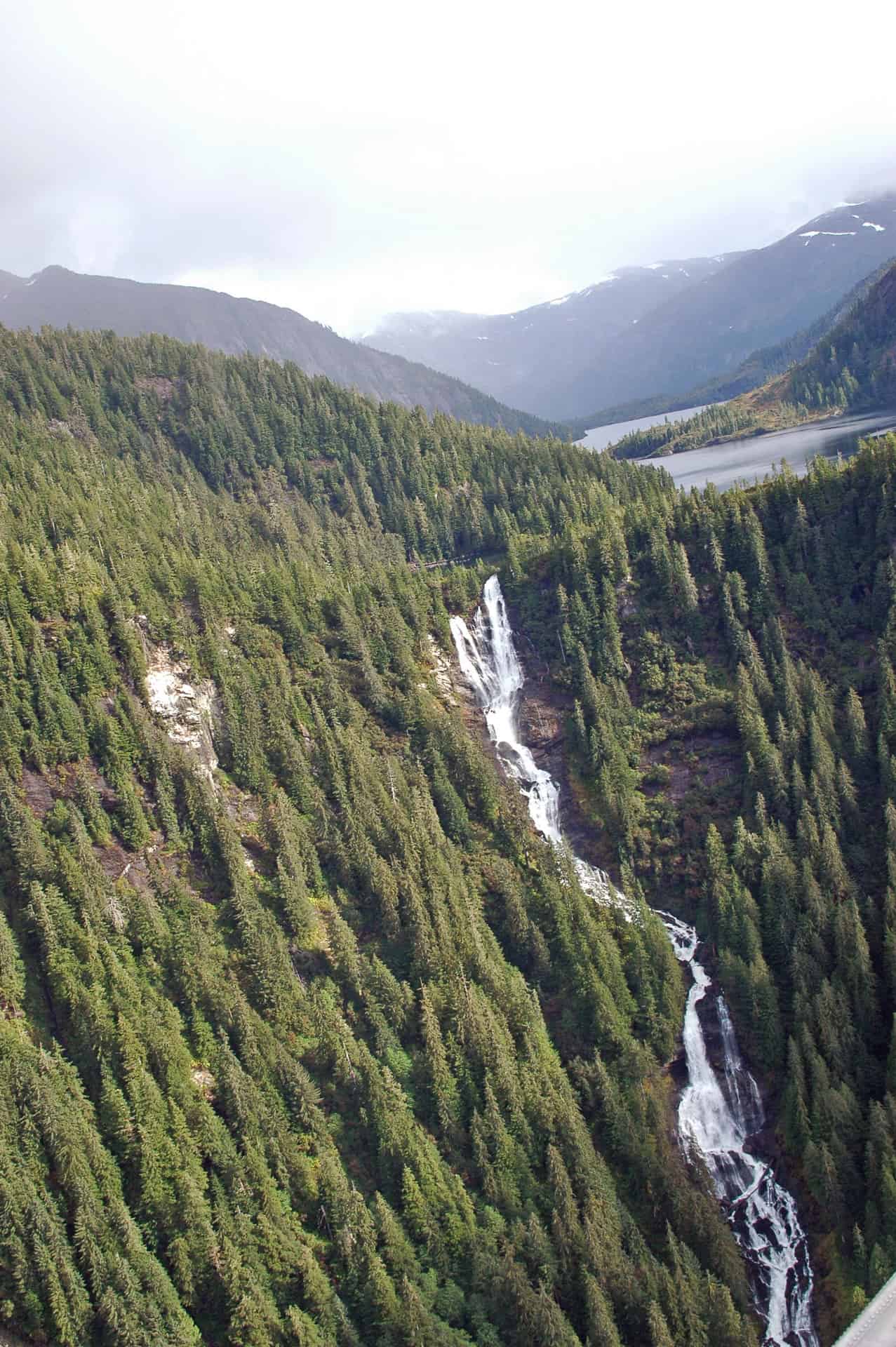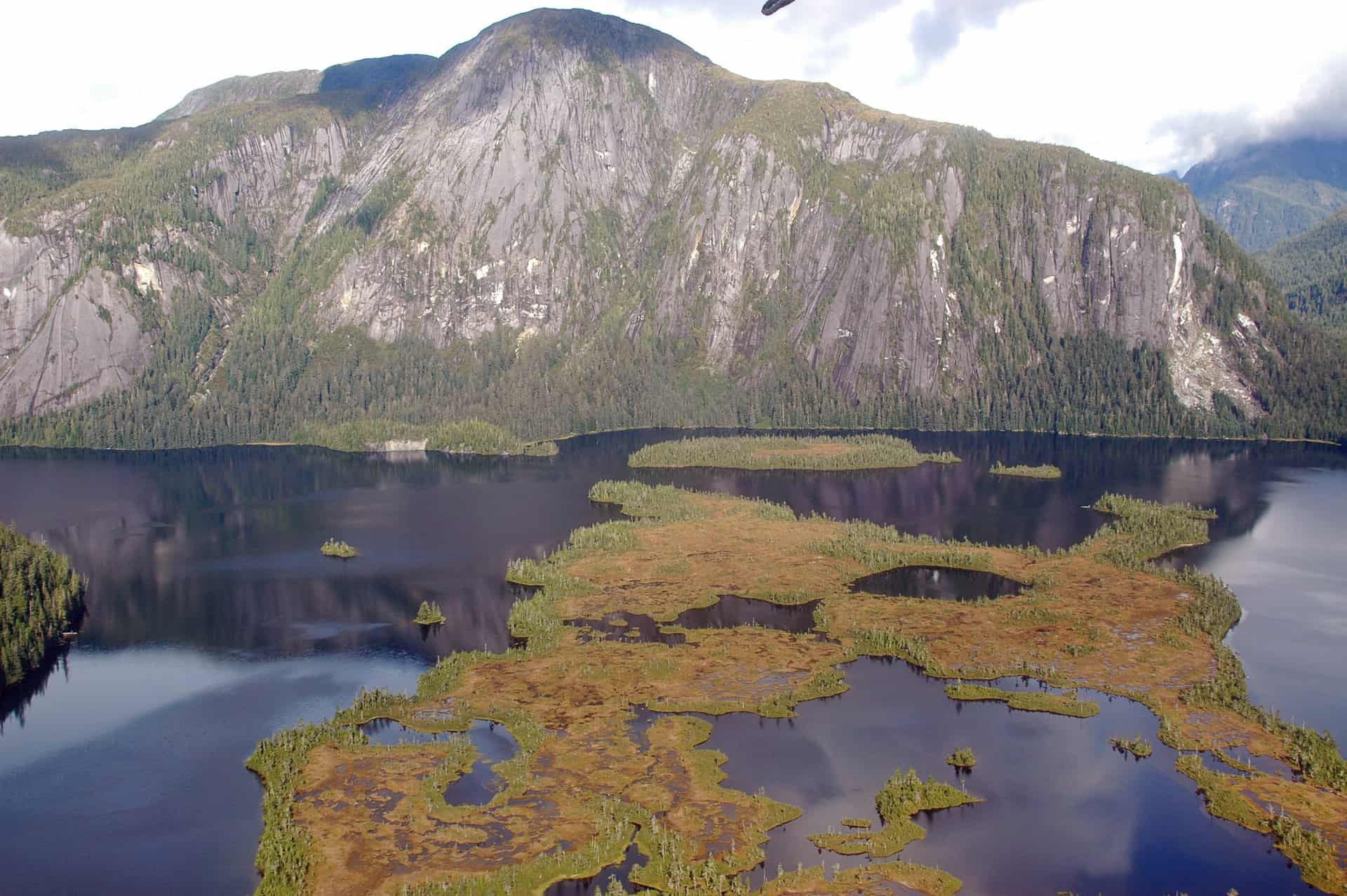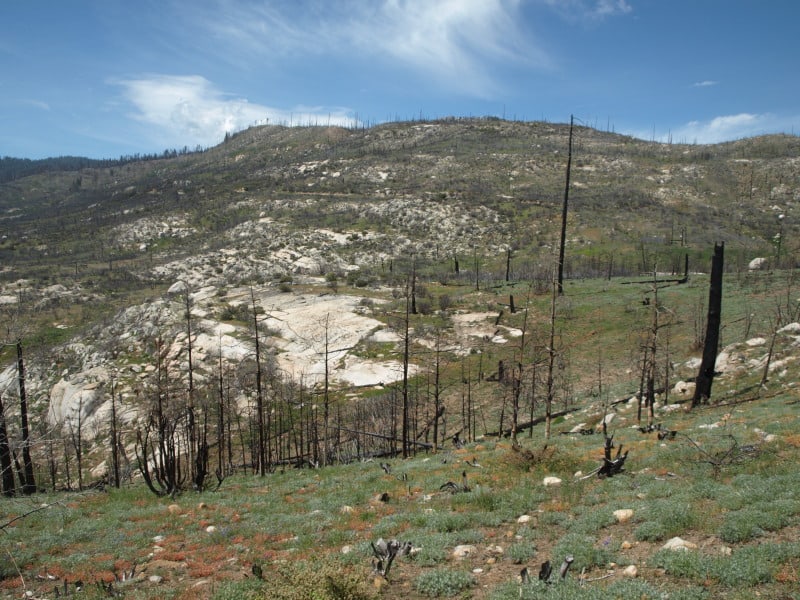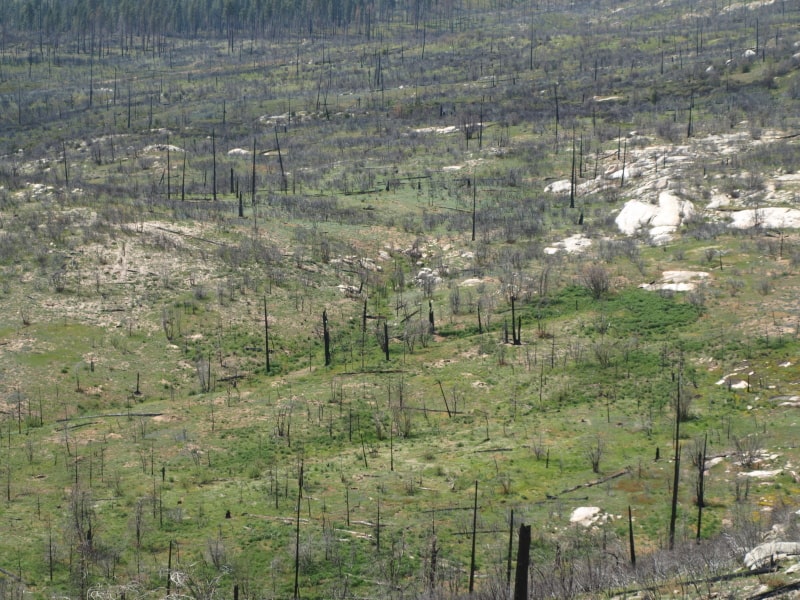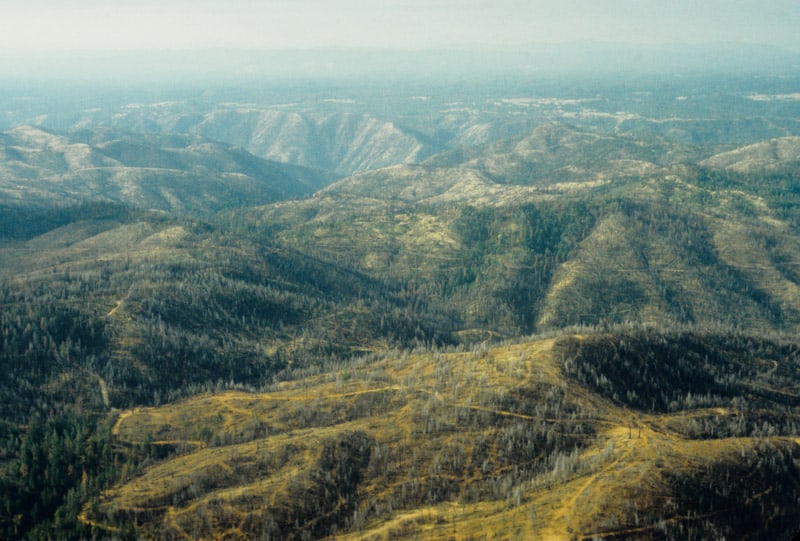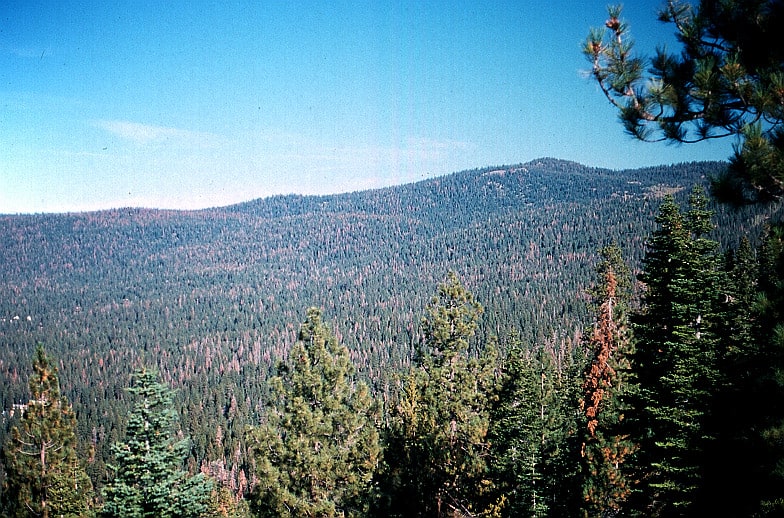
Native trout in full sunlight on a warm day in the headwaters of Blue River, Lane County, Oregon, August 24, 2013. Photograph by Aaron L. Zybach.
This post is generally specific to western Oregon salmonid (salmon and trout) populations in relation to current streamside vegetation buffer regulations. The “paradox” in the title refers to the fact that research work done by Mike Newton and others clearly indicate that Oregon Department of Environmental Quality (DEQ) regulations intended to protect native fish populations are, in fact, counterproductive – that is, salmonids do much better in streams that have been clearcut with no buffering vegetation than they do in streams with partial buffering; which in turn do better than streams with full buffering.
The post follows a discussion that John Persell and I were having on this blog regarding the effects of streambank vegetation on fish:
https://forestpolicypub.com/2013/10/01/federal-forestlands-would-benefit-from-oregon-rules-op-ed-in-oregonian/comment-page-1/#comment-19634
I made the point that I thought fish preferred clearcuts and sunlight to streamside vegetation and shade because they are cold blooded animals and there is usually more food where greater photosynthesis is taking place. Also, that they had responded to millions of years of fluctuating temperature changes in the rivers and streams they inhabited, and that streamside buffers did not provide much lasting effect on potentially hazardous (to fish) stream temperatures. In support of my statements I referenced personal observations (“fishing”) and the work of Mike Newton, a long-time friend and nationally recognized forest ecologist at Oregon State University, regarding a paper he had written several years ago on that topic.
John responded to these assertions with some reasonable questions: “Over what period (time of day, point in spawning cycle, season of year) did Newton determine fish numbers and volume were higher in sunny clearcut areas? What was the size and depth of the stream? At what life stage were the fish? It seems there are a lot of factors to consider before determining fish like clearcuts better than uncut areas.”
John’s challenge caused me to confer directly with Mike in regards to his paper and his own thoughts. As fate would have it (to coin a phrase), Mike was just completing a major article on that very subject, Managing Riparian Forests and the Paradox of Streamside Regulations, for the SAF Journal of Forestry, and was also getting prepared to present his findings to both the regulatory Oregon Environmental Quality Commission (a sub-set of EPA) and to the Oregon Department of Forestry (ODF). These works included references to ten or so reports showing that fish prosper more in clearcuts than in buffered or uncut streams, beginning with Murphy and Hall in 1981.
Several references were listed in the materials Mike provided me (including Murphy and Hall), a selection of which I posted for John’s benefit in regards to his questions:
https://forestpolicypub.com/2013/10/01/federal-forestlands-would-benefit-from-oregon-rules-op-ed-in-oregonian/comment-page-1/#comment-19676
These linked references also serve for the few citations I have included in this post. I have also provided several PDF files from Mike and from my own records at the end of this post, for those interested in original source materials.
The importance of stream temperature to salmonids
One of the earliest studies of the relation between water temperatures and salmonid populations was by Geoffrey Greene in North Carolina in 1950, comparing the different temperatures and trout populations in two streams: one that ran through a forested area, and another exposed to full sun as it ran through farmland. He confirmed that the “maximum temperature limit” for rainbow and brown trout was about 80 degrees Fahrenheit.
The maximum year-long measures of the farm stream varied from 65- to 79 degrees F., while the forest stream never became more than 66 degrees: which Greene considered the “optimum temperature” for brook trout. Neither stream reached 80 degrees during the year. From these findings he concluded: “once-productive trout streams can be restored by the control of stream temperatures through good watershed management.” To achieve that objective he thought it important to manage “all aspects of a watershed as a unit,” rather than be managed “on a piecemeal basis.”
Greene also recognized that trout obtained almost all of their food from aquatic organisms, “which are believed to thrive more abundantly at higher temperatures.” He therefore advised that “the most satisfactory practices would be those that raised the feeder stream temperatures to the maximum productivity of the aquatic organisms, yet did not increase the downstream temperatures above the limit of tolerance” via “the careful manipulation of vegetation and other kinds of land use practices.” Many of Greene’s findings and edicts remain as the basis for managing salmonids and water temperatures in fish bearing streams to this time.
Of greater scientific significance, because of geographic range, technical sophistication of measures, and sheer volume of research over time, is the numerous papers and reports by J. R. Brett, beginning in 1952 and continuing into the 1990’s. Brett’s work regarded the relationship of temperature and food supply for salmonids, and forms the basis of much of Newton’s writing and planned testimony on this topic — as well as provide context for subsequent field research Mike has performed on this topic during the past 22 years, often in collaboration with his long-time research assistant, Elizabeth Cole. Brett’s research showed that the warmer the water, the more productive for well-fed fish up to about 64 degrees F., whereas at 68 degrees well-fed fish grow at 90 percent of the maximum rates observed at lower temperatures; thus confirming, with greater precision, Greene’s findings.
Current Oregon regulations
I was involved in forest management issues as a reforestation contractor when riparian vegetation first became a topic of general discussion and new regulations in the Pacific Northwest during the 1980s. Prior to then the USFS even used to have “stream cleaning” contracts, where contractors were charged with removing all evidence of logging and other management activities from streams – even leaves and small twigs! The work made little sense: twigs, leaves, limbs and trees would keep falling into the stream after the workers left, and were being washed downstream to the ocean in any instance. The first contract I ever did of that nature was also my last, about 15 stream miles from the ocean.
Around the same time efforts were being made to save remaining old-growth trees from being logged and large amounts of land were thus being set aside and put off limits to logging. Soon, hydrologists and fish biologists followed this lead and began championing similar set asides for riparian areas, claiming the trees and shrubs were needed to 1) help off-set erosion and 2) provide good habitat for fish. Regulations followed, and harvesting next to a stream bank was soon forbidden. The argument quickly became how wide unlogged stream “buffers” should be, and regulations began being revised and more riparian land began being removed from management operations.
The research of Newton and Cole and others examined whether buffers lead to acceptable regulatory standards for fish-bearing streams. These studies revealed that small differences within buffer rules can make the difference between meeting or not meeting desired standards. Thirty-two streams with full regulatory buffers were measured over time, but State of Oregon forests had somewhat wider buffers than the current rules required, as set forth in the Protection of Cold Water Standard criterion for the Oregon Department of Environmental Quality (DEQ).
This triggered the question of whether wider buffers might be necessary. The DEQ study considered only buffer width on both sides of a stream, and water temperature, but did not consider other factors influencing the fishery; i.e., the very resource buffers were intended to protect, salmonids, did not factor into the findings – as a result, the several reports of general increase in fish productivity when clearcuts extended to the water’s edge (including those of Newton’s research) were not considered in the state-sponsored study of the use of buffers in meeting the regulatory criteria.
The history of disturbance
History tells us that fish have evolved and survived disturbances far more severe and widespread than clearcut logging, including: windstorms, catastrophic wildfires, volcanic eruptions, mass flooding, major landslides, etc. Such disturbances have almost always resulted in significant changes to streamside shading. Native fish have therefore survived and evolved with fluctuating stream temperatures — daily, seasonally, and occasionally. Their ability to swim to more favorable conditions during these changes should not be discounted.
As one result, the DEQ standard of 64 degrees F. for most of the salmonids and their habitats in Oregon fits neither the streams nor the fishery. The streams vary so much, and the environments in which they flow vary so much, that one standard cannot be made to adapt the fisheries that are acclimated to those streams. Neither the streams nor the fish are as homogenous as the standards; they never have been and they never can be.
Research Methods
The DEQ criterion for protecting the cold water standard is that no forest practice shall allow an increase in the 7-day mean temperature of water of 0.5 degrees F. or more downstream from a forestry operation, regardless of the natural temperature of the stream. This requirement eliminated any forestry operation intended to maintain the riparian forest — or to provide improved growth and health of affected fish. A technical problem is that existing temperature measuring equipment is only sensitive to plus or minus 0.32 degrees F., with a range of 0.64 degrees. Moreover, year-to-year variation in natural stream temperature is well over one degree. That means the only way to enforce this criterion is to require that there be no change at all in the riparian forest cover.
Germane to the above considerations is what, other than temperature, limits primary productivity of streams. Answer: short-wave light energy, and the photosynthetic process that supports the food chain. Newton and Cole’s research in the past 22 years has employed well over 100 thermistors registering summer-long stream temperatures along several streams. Their placements bracket clearcuts, partial buffers, and ODF’s Best Management Practices (BMP) streamside buffers. The instruments have recorded years before harvests and 5-17 years following harvests of several kinds.
Study streams range from eastern Douglas County to northern Lincoln County, all in western Oregon, in both the Coast and Cascade mountain ranges. The work is part of the Oregon State University (OSU) Watershed Research Cooperative (WRC), an organization with several other large watersheds under close examination. Streams in the WRC study range from maximum summer temperatures of 50- to 68 degrees F. – all well within the desired range of temperature conditions for salmonids.
Newton and Cole’s research within the WRC involved four low to medium elevation streams with basins of 600 to 1000 acres each to determine how the arrangement and amount of streamside buffers in clearcut units influenced stream and air temperatures. Conditions included no-tree buffers, partial buffers 40-feet wide, and two-sided BMP buffers 50- to 100-feet wide. Impacts of clearcut logging on stream temperatures were determined based on time series analyses of post-harvest trends compared to pre-harvest trends.
Research Findings
Trends for daily maximums and means significantly increased after clearcutting in no-tree buffer units. Partial buffers led to slight (less than 4 degrees F.) or no increased warming. BMP units led to significantly increased warming, slight warming, or no increased warming, depending upon the stream. The effects of clearcutting and different buffers on daily minimum temperatures also varied by stream. Maximum temperature peaks were not maintained in downstream units; that is, elevated temperatures quickly returned to average stream temperatures within short distances.
Clearcutting led to increases in daily maximum and mean air temperatures above the stream for most buffer designs, with the greatest increases in the no-tree units. Changes to daily minimum air temperatures varied among buffer design and streams. Although there were some inconsistencies in trends with different buffer designs among the streams, there were also some differences related to buffer implementation, changes in radiation, and stream features.
Brett (1956), Brett et al (1982), and Sullivan et al (2000) have all described tolerance of fish to elevated temperatures, the ability of fish to adapt with only 24 hours of adaptation time, and the very critical role of food availability with rising temperature. Viability of fish at temperatures 77 degrees F. and above depend on duration of exposure. The importance attached to stream temperature in regards to fish has been widely cited, but seldom with respect to the variability with which fish can respond within a range of responses.
The differences between units in fish biomass and other parameters were negligible before clearcutting in the spring of 2005, and all cut units increased in the three years following logging. Clearcuts with no buffers showed the largest positive response — but all cut units measured better than any unlogged units.
Peak temperatures above 64 degrees F. are necessary to achieve mean temperatures in the optimum range for salmonid metabolism. The daily fluctuations of temperatures ranged from 2 degrees to 4 degrees F. in most forest streams within the study areas, with brief peaks and very productive means.
Stream reaches with some direct sun on them were the most productive for both the food chain and the fishery as long as they didn’t exceed 71 degrees F. To this point, none of the study area streams have reached that level.
Temperature changes in logged units did not persist more than briefly downstream as water moved into other environments. Water temperature equilibrates rapidly with its local environment. It naturally rises as it goes downhill, and remains very warm in interior valleys, gaining heat each day and losing it each night.
Why fish like light
Newton and Cole’s streams have compared buffer designs from no harvest to standard ODF buffers to residual-tree screens that shelter streams from the sun (one-sided buffer) between 9AM to 5 PM (daylight time), and units with no buffer other than scattered shrubs. Brome Creek, a tributary to Hinkle Creek, the site of a major WRC basin-sized study in the western Cascades of Douglas County, demonstrated that full sunlight on the stream provided twice as much fish biomass as any other harvested unit, and all three harvested units produced more fish than any of the uncut units between harvested units.
Light clearly is responsible for fish growth. This was despite the complete clearcut units reaching maximum (but not mean) temperatures of 71 degrees F., and was frequently above 64 degrees. The harvested units on Brome Creek ranged above 64 degrees before harvest. Newton’s studies in several of these streams showed that the periphyton and macroinvertebrate abundance (“fish food”) was greatest where the most light reached the streams. On all streams peak temperatures were within the range defined by Brett et al (1982) in which fish growth was roughly 80-100 percent of growth observed at 62 degrees; the optimum. This level of productivity is reached only when temperature exceeds about 57 degrees. It is by no means a harmful temperature.
The argument against homogenized standards
Several factors weigh against a single set of criteria for all streams. First, fish tolerate a wide range of temperatures. Mortality of salmonids begins only when held above 75 degrees F. for an extended period of time. Above this temperature mortality becomes a function of the duration of time in which fish are subjected to warmer temperatures.
Brief excursions to such temperatures reduce feeding rate and raise respiration reversibly, leading to slow or even cessation of growth before mortality begins. A single regulatory criterion (e.g., 64 degrees F,) does not capture the evidence that even though the constant temperature where growth is near or at maximum if well fed, 68 degrees F. is tolerated with only a 10 percent decrease in growth from the maximum; it is still a very favorable temperature.
Newton’s observations of highest stream productivity occurred when streams were fully exposed to sun, and when summer temperature peaks were well above the numeric criteria, revealing serious and costly flaws in the regulatory process.
The notion of requiring more shade when less shade equates to more biological productivity of streams represents a conflict between regulatory convenience (meeting a numerical criterion) and resource sensitivity (increasing fish biomass). Moreover, many streams are far too cold for optimum fish metabolism, and yet the Protecting Cold Water Standard prohibits operations that would provide both a more productive temperature range, but also improved food supplies.
Recommendations
Newton makes the following recommendations, based on his own research and the research of others:
1) The approach to stream quality should be one that first reflects that:
a) water quality in most Oregon commercial forest lands is excellent;
b) existing quality is protected by forest management that actively maintains streamside cover in direct proportion to stream temperatures; and
c) fisheries are not limited by temperature if good at the time of proposed harvest.
2) There should be flexibility in harvesting toward options that allow optimizing the harvest in order to improve fisheries productivity according to initial condition:
a) cold streams should be allowed (or even encouraged) to design harvests with no buffer; streams running 90-day mean averages of 59 degrees to 63 degrees before harvest should be allowed (or encouraged) to design a sun-sided partial buffer that would permit increased productivity in both fisheries and forest growth.
b) warmer streams should be allowed a sun-sided partial buffer plus a narrow screen of residual trees, which would increase forest and fisheries productivity with no appreciable change in temperature.
3) Such an approach is forest management friendly, fish friendly, and allows (or encourages) periodic entry into buffering forests in order to maintain optimum conditions — an activity not allowed by current rules.
References
https://forestpolicypub.com/2013/10/01/federal-forestlands-would-benefit-from-oregon-rules-op-ed-in-oregonian/comment-page-1/#comment-19676
Greene, Geoffrey E. 1950. “Land Use and Trout Streams,” Journal of Soil and Water Conservation, Vol. 5, No. 3: 125-126.
www.esipri.org/Library/Greene_1950.pdf
Newton, Michael 1996-2013. Select Publications and Brome Creek Presentation.
www.esipri.org/Library/Newton_Michael/
Seeds, Joshua 2011 Nonpoint Source Compliance With the Protecting Cold Water Criterion of the Temperature Standard. Protecting Cold Water Criterion Internal Management Directive, State of Oregon Department of Environmental Quality, Portland, Oregon: 12 pp.
www.esipri.org/Library/Seeds_2011.pdf
Zybach, Bob and George Ice 1997. “Revisiting the Botkin Salmon Study,” IN: Proceedings of the 1997 NCASI West Coast Regional Meeting, Special Report No. 97-13, National Council for Air and Stream Improvement (NCASI), Corvallis, Oregon: 276-321.
www.nwmapsco.com/ZybachB/Reports/1997_NCASI_Salmon/
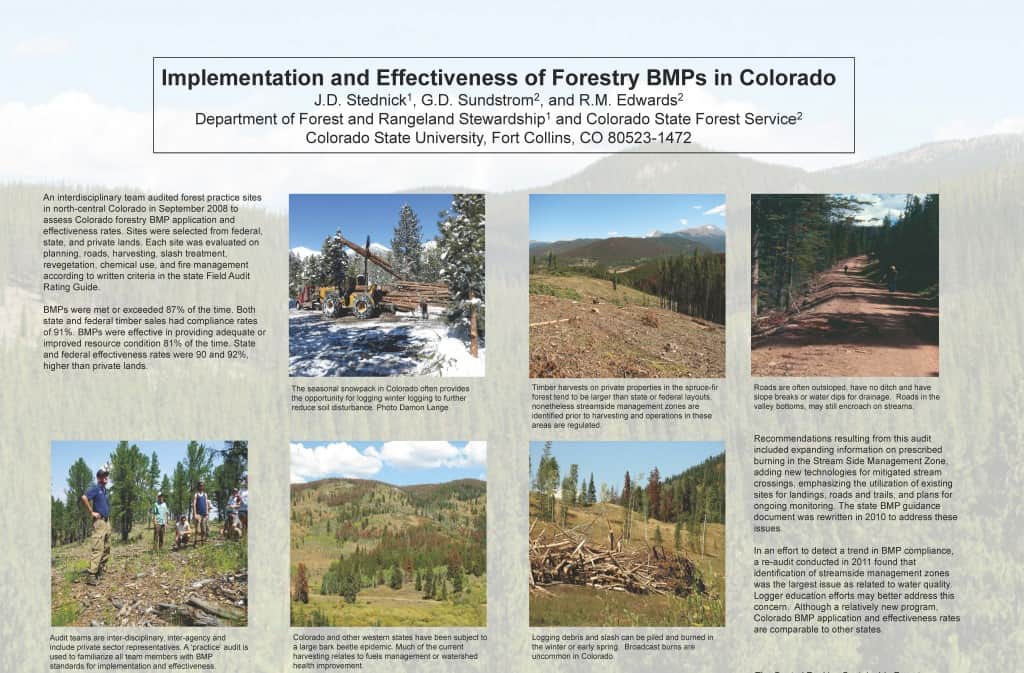 Note: This is only the top half of the Colorado poster.. I got an http error when I tried to upload the whole thing. Perhaps it was too large??
Note: This is only the top half of the Colorado poster.. I got an http error when I tried to upload the whole thing. Perhaps it was too large??